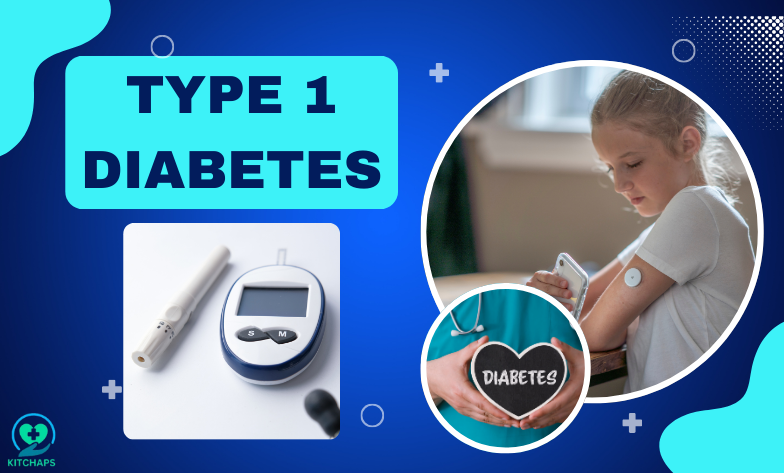Imagine waking up in the morning and discovering that your body can’t regulate glucose, the primary fuel for your body. Well, this is not a suppositional scenario but a real one. Sometimes type 1 diabetes is misunderstood as similar to type 2 diabetes. Also there are spreading misconceptions about its supervision and prevention. This blog will guide you through what is type 1 diabetes is, its symptoms, causes, diagnosis, and the need for self-care. If you are seeking some information about this or supporting someone, you will find updated facts here.
What is Type 1 Diabetes?
Type 1 diabetes is known by Juvenile Diabetes or insulin-dependent Diabetes. It is a long-term autoimmune condition. In this, the pancreas is not able to develop insulin. Insulin hormone is used to permit glucose to enter cells to produce energy. Your blood sugar level increases, which causes damage to the body without insulin. It appears in childhood and adolescence, and also develops in adults. After a lot of research, this condition is not curable, but it is managed by quantity of glucose in the blood by using insulin, a healthy diet, and some lifestyle changes.
Causes: Why does it happen?
The exact cause of type 1 diabetes is not known, but some research says this is caused by both genetic as well as environmental reasons. Here are the reasons:
Response of Autoimmune: It attacks the immune system and damages the pancreas cells that produce insulin.
Genetic: Some genes increase the chances, but do not fully develop this condition.
Environmental: Some of the viral infections increase the chance because they affect people with genetically allowing people.
Lifestyle: Lifestyle, diet, weight gain, or inactivity are not the reasons.
Symptoms: Type 1 Diabetes
Its signs can build instantly and have a chronic impact, particularly in children. Some of the symptoms and signs of it include:
- Unexpected loss of weight
- Blurry Vision
- High Appetite
- Getting Mood Swings
- Heavy breathing
- Repeated Urination
- Fatigue and tiredness
- Feeling thirsty a lot
- Fruity breath
Sometimes, particularly in children these signs mistaken as flu. Adults makes a misconception about due to ageing or it can be stress. In some situations, the primary symptom is a life-risk condition which is called DKA (Diabetic Ketoacidosis). It breaks the fat and produces dangerous acid called ketones.
Diagnosis: The path of clarity
It involves the combined blood tests and medical assessment. The common diagnostic tests are:
FPG (Fasting Plasma Glucose): If fasting blood sugar level is 126 mg/dL or higher.
RPG (Random Plasma Glucose): A value of 200 mg/dL or higher with signs confirms it.
Hemoglobin A1C: The average level of blood sugar is 6.5% or higher over the last 3 months.
Autoantibody Tests: They guide in making a distinction between type 1 and type 2 diabetes with the help of immune markers.
C-peptide Test: It determines the quantity of insulin, our body is producing.
Sometimes, Ketone testing is used by using a urine or blood sample. It is done to know if a patient with type 1 diabetes has ketoacidosis or not. Testing is done when blood sugar level is higher than 240 mg/dL, during pneumonia, heart attack, while nausea and vomitting and during pregnancy.
Insulin: Lifesaving Hormone
For patients with type 1, insulin therapy is essential for survival in life because our body is not able to produce insulin, so it is supplied externally.
- Insulin Injections: Through syringes and various times daily.
- Insulin Pumps: Devices that can be worn through a small tube under the skin.
- CGM (Continuous Glucose Monitors): It traces the blood sugar levels, sometimes put together with insulin pumps.
Prevention and Treatment: Is Type 1 Diabetes avoidable?
Type 1 diabetes is chronic. Those are diagnosed with it have to stay in the hospital. You need to have a regular checkup every week to have control over your blood sugar level. Your doctor will review the outcomes of the urine test and blood sugar. He/She will also take a glance at meals and insulin injections. When your diabetes becomes stable, you will have to visit your doctor frequently. Your doctor will tell you to meet a dietitian or nutritionist and and certified diabetes care and education specialist (CDCES), as they will help in managing diabetes.
Currently, there is no proof of preventing type 1 diabetes. Type 2 is cured and managed by making some lifestyle changes and following a healthy diet, but type 1 is not cured by following these things. Much research is still going on for its prevention. But for now, early diagnosis and treatment are necessary.
Conclusion
Diagnosis of type 1 is a life-changing event, and with updated insulin therapy, monitoring of glucose, and self-care, patients lead a fully active life. By understanding about disease, signs early encourage an approach of self-care.
Frequently Asked Questions (FAQs):
A. It is an autoimmune condition where the immune system damages the insulin-producing cells in the pancreas. It leads to a high blood sugar level and requires insulin therapy.
A. No, currently there is no cure for type 1 diabetes.
A. Monitoring of blood sugar level, taking insulin therapy daily, eating a healthy diet, doing regular exercise, and regularly consulting with your doctor.
A. Unexpected weight loss, tiredness, blurry vision, and sometimes a fruity smell in the breath.
Disclaimer: The information provided is only for knowledge. It is not medical advice; always consult your doctor before taking any treatment. Do not overlook the doctor’s medical advice because you have read it here.
Read more about:

